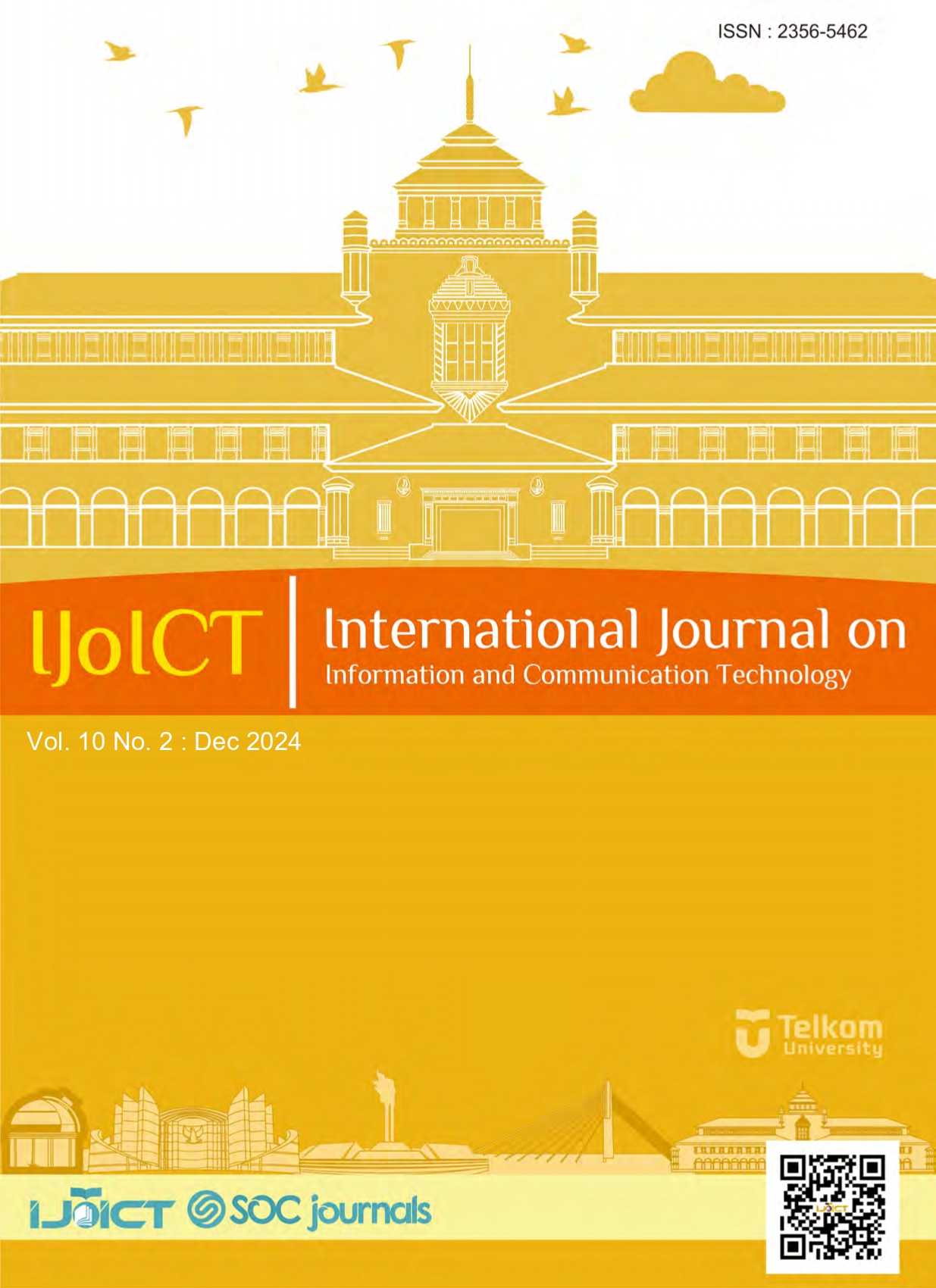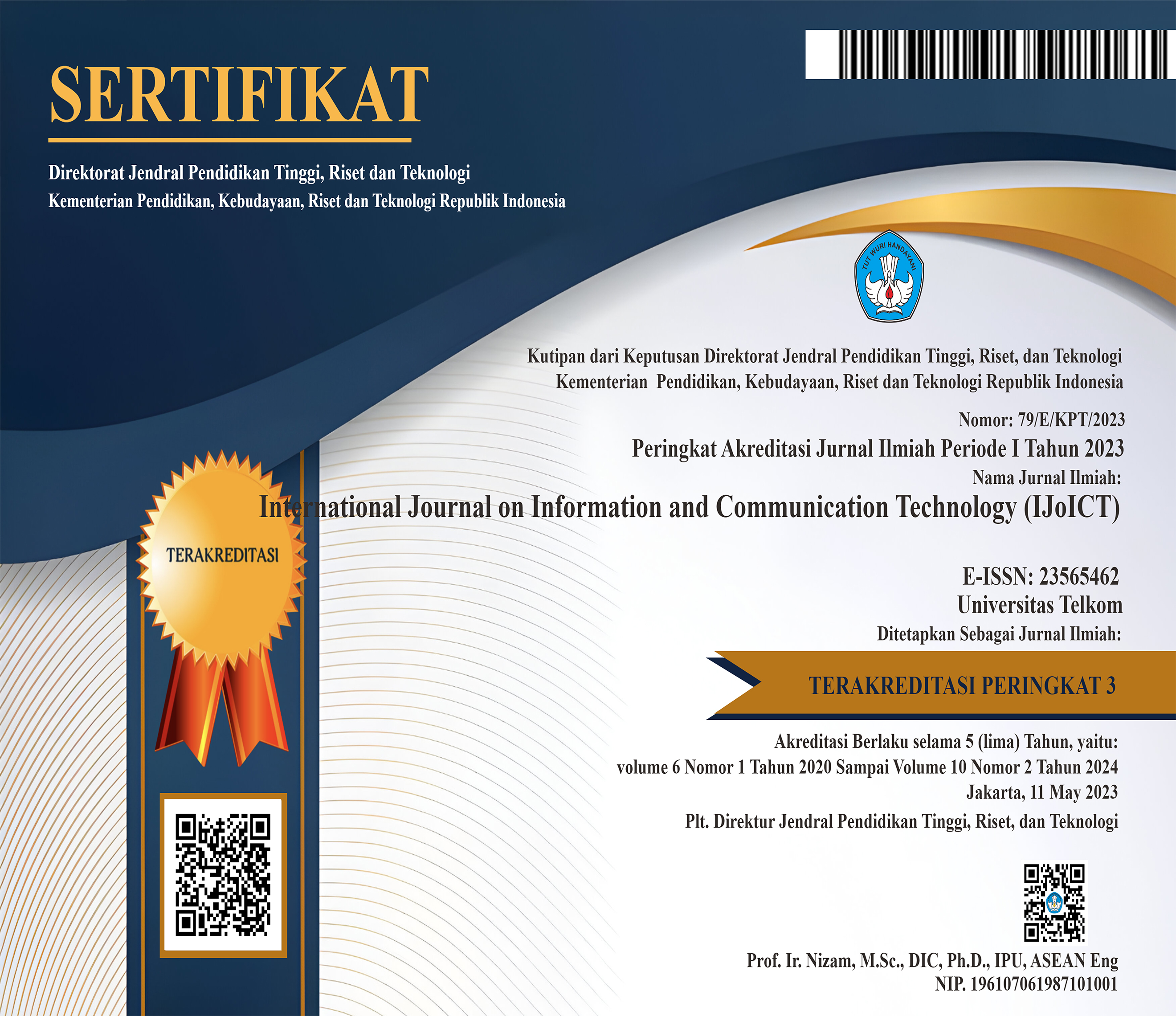Classification Prediction of Dengue Fever Spread Using Decision Tree with Time-Based Feature Expansion
DOI:
https://doi.org/10.21108/ijoict.v10i2.1026Keywords:
Incidence Rate, DHF, Decision Tree, Feature Expansion, ClassificationAbstract
In Indonesia, dengue hemorrhagic fever (DHF) has become a serious community health concern due to fluctuating incidence rates influenced by several factors. It requires comprehensive control strategies to prevent the rise of the incidence. This study seeks to classify the future spread of DHF in Bandung City, accompanied by optimal factors that influence the increase in its spread. This study proposes using Decision Tree to predict a classification of dengue hemorrhagic fever (DHF) spread with implementation of spatial time-based feature expansion. The developed scenario is to build a target class classification prediction model based on the previous time period. From the developed scenario, the selected model has optimal performance to form a classification prediction model in the future. The results obtained show that the performance of Decision Tree using time-based feature expansion is more than 90%. The contribution of this study is to inform the public and health institution regarding DHF spread for the future and influential factor so that the government can provide policies as early as possible to prevent DHF spread.
Downloads
References
[1] “Ministry of Health of the Republic of Indonesia. 2023. Profil Kesehatan Indonesia 2022. Accessed from https://kemkes.go.id/id/profil-kesehatan-indonesia-2022..”
[2] “Ministry of Health of the Republic of Indonesia. 2024. Profil Kesehatan Indonesia 2023. Accessed from https://kemkes.go.id/id/profil-kesehatan-indonesia-2023.”.
[3] “Jumlah Kasus Demam Berdarah Dengue (DBD) Menurut Puskesmas di Kota Bandung (2016-2022)”.
[4] A. Rahman and S. S. Prasetiyowati, “Performance Analysis of the Hybrid Voting Method on the Classification of the Number of Cases of Dengue Fever,” International Journal on Information and Communication Technology (IJoICT), vol. 8, no. 1, pp. 10–19, Jul. 2022, doi: 10.21108/ijoict.v8i1.614.
[5] T. A. Assegie, R. L. Tulasi, and N. K. Kumar, “Breast cancer prediction model with decision tree and adaptive boosting,” IAES International Journal of Artificial Intelligence (IJ-AI), vol. 10, no. 1, p. 184, Mar. 2021, doi: 10.11591/ijai.v10.i1.pp184-190.
[6] Y. Liu, C. Zhang, X. Zheng, Y. Liu, and J. He, “Stroke Prediction Model Based on Decision Tree,” WSEAS TRANSACTIONS ON BIOLOGY AND BIOMEDICINE, vol. 20, pp. 24–27, Mar. 2023, doi: 10.37394/23208.2023.20.3.
[7] S. S. Prasetiyowati and Y. Sibaroni, “Unlocking the potential of Naive Bayes for spatio temporal classification: a novel approach to feature expansion,” J Big Data, vol. 11, no. 1, p. 106, Aug. 2024, doi: 10.1186/s40537-024-00958-x.
[8] R. N. Nurriadi, S. S. Prasetiyowati, and Y. Sibaroni, “Performance of Time-Based Feature Expansion Classification Method for Predicting Disease Spread,” in 2024 2nd International Conference on Software Engineering and Information Technology (ICoSEIT), IEEE, Feb. 2024, pp. 120–125. doi: 10.1109/ICoSEIT60086.2024.10497460.
[9] Elqi Ashok, Sri Suryani Prasetiyowati, and Yuliant Sibaroni, “DHF Incidence Rate Prediction Based on Spatial-Time with Random Forest Extended Features,” Jurnal RESTI (Rekayasa Sistem dan Teknologi Informasi), vol. 6, no. 4, pp. 612–623, Aug. 2022, doi: 10.29207/resti.v6i4.4268.
[10] S. Parveen et al., “Dengue hemorrhagic fever: a growing global menace,” J Water Health, vol. 21, no. 11, pp. 1632–1650, Nov. 2023, doi: 10.2166/wh.2023.114.
[11] L. R. Alma et al., “Rapid Survey of Mosquito Larvae Density with a History of Dengue Hemorrhagic Fever,” E3S Web of Conferences, vol. 448, p. 05003, Nov. 2023, doi: 10.1051/e3sconf/202344805003.
[12] S. N. Ramadhani and Mohd. T. Latif, “Impact of Climate Change on Dengue Hemorrhagic Fever (DHF) in Tropical Countries: A Literature Review,” JURNAL KESEHATAN LINGKUNGAN, vol. 13, no. 4, p. 219, Oct. 2021, doi: 10.20473/jkl.v13i4.2021.219-226.
[13] N. Iqbal, M. A. R. Afridi, Z. Ali, and A. Rafiq, “Association of different blood groups in patients with Dengue fever and their relationship with the severity of the illness,” Pak J Med Sci, vol. 39, no. 5, Jul. 2023, doi: 10.12669/pjms.39.5.7275.
[14] M. R. Hashan, S. Ghozy, A. E. El‐Qushayri, R. H. Pial, M. A. Hossain, and G. M. Al Kibria, “Association of dengue disease severity and blood group: A systematic review and meta‐analysis,” Rev Med Virol, vol. 31, no. 1, pp. 1–9, Jan. 2021, doi: 10.1002/rmv.2147.
[15] F. Amalia Febrianti, E. Qurniyawati, M. Atoillah Isfandiari, and N. Mohamed Gomaa Nasr, “AN EPIDEMIOLOGICAL OVERVIEW OF DENGUE HEMORRHAGIC FEVER (DHF) CASES IN KEDIRI REGENCY DURING 2017-202,” Jurnal Berkala Epidemiologi, vol. 11, no. 3, pp. 215–223, Sep. 2023, doi: 10.20473/jbe.V11I32023.215-223.
[16] E. T. Suryani, “Profile of Dengue High Fever in Blitar City at 2015-2017,” Jurnal Berkala Epidemiologi, vol. 6, no. 3, p. 260, Dec. 2018, doi: 10.20473/jbe.V6I32018.260-267.
[17] S. Tomia, U. K. Hadi, S. Soviana, and E. B. Retnani, “EPIDEMIOLOGY OF DENGUE HEMORRHAGIC FEVER CASES IN TERNATE CITY, NORTH MOLUCCAS,” Jurnal Veteriner, vol. 21, no. 4, pp. 637–645, Dec. 2020, doi: 10.19087/jveteriner.2020.21.4.637.
[18] K. N. Babar, “Performance Evaluation of Decision Trees with Machine Learning Algorithm,” INTERANTIONAL JOURNAL OF SCIENTIFIC RESEARCH IN ENGINEERING AND MANAGEMENT, vol. 08, no. 05, pp. 1–5, May 2024, doi: 10.55041/IJSREM34179.
[19] D. Saha and A. Manickavasagan, “Machine learning techniques for analysis of hyperspectral images to determine quality of food products: A review,” Curr Res Food Sci, vol. 4, pp. 28–44, 2021, doi: 10.1016/j.crfs.2021.01.002.
[20] X. Zhao and X. Nie, “Splitting Choice and Computational Complexity Analysis of Decision Trees,” Entropy, vol. 23, no. 10, p. 1241, Sep. 2021, doi: 10.3390/e23101241.
[21] F. K. Nasser and S. F. Behadili, “Breast Cancer Detection using Decision Tree and K-Nearest Neighbour Classifiers,” Iraqi Journal of Science, pp. 4987–5003, Nov. 2022, doi: 10.24996/ijs.2022.63.11.34.
[22] L. Li, F. Li, and Y. Kang, “Forecasting large collections of time series: feature-based methods,” Sep. 2023.
[23] D. Jung, J. Lee, and H. Park, “Feature expansion of single dimensional time series data for machine learning classification,” in 2021 Twelfth International Conference on Ubiquitous and Future Networks (ICUFN), IEEE, Aug. 2021, pp. 96–98. doi: 10.1109/ICUFN49451.2021.9528690.
[24] F. Y. Pritama, S. Suryani Prasetiyowati, and Y. Sibaroni, “Enhancing SVM Performance for Time-Based Classification Prediction Through Feature Expansion: A Comparative Analysis with LSTM,” in 2024 12th International Conference on Information and Communication Technology (ICoICT), IEEE, Aug. 2024, pp. 43–49. doi: 10.1109/ICoICT61617.2024.10698663.
[25] D. Singh and B. Singh, “Investigating the impact of data normalization on classification performance,” Appl Soft Comput, vol. 97, p. 105524, Dec. 2020, doi: 10.1016/j.asoc.2019.105524.
[26] B. G. Chepino, R. R. Yacoub, A. Aula, M. Saleh, and B. W. Sanjaya, “EFFECT OF MINMAX NORMALIZATION ON ORB DATA FOR IMPROVED ANN ACCURACY,” Journal of Electrical Engineering, Energy, and Information Technology (J3EIT), vol. 11, no. 2, p. 29, Aug. 2023, doi: 10.26418/j3eit.v11i2.68689.
[27] M. Hayaty, S. Muthmainah, and S. M. Ghufran, “Random and Synthetic Over-Sampling Approach to Resolve Data Imbalance in Classification,” International Journal of Artificial Intelligence Research, vol. 4, no. 2, p. 86, Jan. 2021, doi: 10.29099/ijair.v4i2.152.
[28] E. Saputro and D. Rosiyadi, “Penerapan Metode Random Over-Under Sampling Pada Algoritma Klasifikasi Penentuan Penyakit Diabetes,” Bianglala Informatika, vol. 10, no. 1, pp. 42–47, Mar. 2022, doi: 10.31294/bi.v10i1.11739.
[29] S. S. Prasetiyowati, A. Yahya, and A. A. Rochmawati, “Performance of Time-Based Feature Expansion in Developing ANN Classification Prediction Models on Time Series Data,” Intl. Journal on ICT, vol. 9, no. 2, pp. 162–176, 2023, doi: 10.21108/ijoict.v9i2.868.
[30] D. P. -, S. N. -, A. A. C. -, and A. G. -, “Enhancing Heart Disease Prediction Through KBEST-PCA Fusion Feature Selection and Ensemble Modeling With Gaussian Naive Bayes Boosting,” International Journal For Multidisciplinary Research, vol. 5, no. 4, Jul. 2023, doi: 10.36948/ijfmr.2023.v05i04.4378.
[31] R. Blanquero, E. Carrizosa, C. Molero-Río, and D. Romero Morales, “Optimal randomized classification trees,” Comput Oper Res, vol. 132, p. 105281, Aug. 2021, doi: 10.1016/j.cor.2021.105281.
[32] B. Charbuty and A. Abdulazeez, “Classification Based on Decision Tree Algorithm for Machine Learning,” Journal of Applied Science and Technology Trends, vol. 2, no. 01, pp. 20–28, Mar. 2021, doi: 10.38094/jastt20165.
[33] S. Tangirala, “Evaluating the Impact of GINI Index and Information Gain on Classification using Decision Tree Classifier Algorithm*,” International Journal of Advanced Computer Science and Applications, vol. 11, no. 2, 2020, doi: 10.14569/IJACSA.2020.0110277.
[34] S. Mokhtari, K. K. Yen, and J. Liu, “Effectiveness of Artificial Intelligence in Stock Market Prediction based on Machine Learning,” Int J Comput Appl, vol. 183, no. 7, pp. 1–8, Jun. 2021, doi: 10.5120/ijca2021921347.
[35] M. Heydarian, T. E. Doyle, and R. Samavi, “MLCM: Multi-Label Confusion Matrix,” IEEE Access, vol. 10, pp. 19083–19095, 2022, doi: 10.1109/ACCESS.2022.3151048.
[36] K. Wabang, Oky Dwi Nurhayati, and Farikhin, “Application of The Naïve Bayes Classifier Algorithm to Classify Community Complaints,” Jurnal RESTI (Rekayasa Sistem dan Teknologi Informasi), vol. 6, no. 5, pp. 872–876, Nov. 2022, doi: 10.29207/resti.v6i5.4498.
[37] M. A. Rosid, A. S. Fitrani, Y. Findawati, S. Winata, and V. A. Firmansyah, “Classification Of Dengue Hemorrhagic Disease Using Decision Tree With Id3 Algorithm,” J Phys Conf Ser, vol. 1381, no. 1, p. 012039, Nov. 2019, doi: 10.1088/1742-6596/1381/1/012039.
Downloads
Published
How to Cite
Issue
Section
License

This work is licensed under a Creative Commons Attribution 4.0 International License.
Manuscript submitted to IJoICT has to be an original work of the author(s), contains no element of plagiarism, and has never been published or is not being considered for publication in other journals. Author(s) shall agree to assign all copyright of published article to IJoICT. Requests related to future re-use and re-publication of major or substantial parts of the article must be consulted with the editors of IJoICT.








.png)

.jpg)




